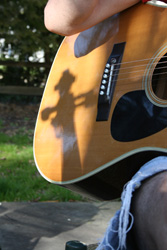Hannah Cressy ’13 continues her report on the service learning factor of Wesleyan’s inter-disciplinary course Ritual, Health, and Healing.

Our “Ritual, Health, and Healing” class returned to Greenpoint-Williamsburg, Brooklyn this past Saturday to continue our conversations with community members and to do more historical research and neighborhood exploration. We are focused on seeing and collecting (interviews, photo, film, trash, and more) and are planning to give our account to members of the Greenpoint-Williamsburg neighborhood in two weeks. Our projects range from a short film to a waste transfer station walking tour, but all are meant to aid local grassroots organizations with their long-running goals of community awareness, communication, and activism. The past two visits have greatly expanded our concepts of health and healing; both are intertwined with environmental conditions, politics, neighbor dynamics, educational equality, and simply feeling seen and heard in a city of 8 million.
David and Pat Dobosz, two local public school teachers, met with us again to have breakfast and taught us much more about educational reform in New York. They spoke of the influx of charter schools and its effect on the economic, academic and emotional lives of local families. Having met and married as public school teachers in their youth, they have been active for over forty years in the struggle for inclusive and equal public education for Brooklyn’s children. Both David and Pat teach in buildings recently invaded by charter schools; they described the plunge in self-worth experienced by their students when charter school students receive better facilities and supplies than their public school. Furthermore, we were surprised and upset to learn that charter schools generally do not accept students with Individual Education Plans, learning disabilities, and developmental disabilities, effectively reversing disability activists’ endless struggle for integrated classrooms. David and Pat are active in the Grassroots Education Movement of New York and showed us much of their film, “The Inconvenient Truth Behind Waiting for Superman”.

A group of students especially interested in education equality continued the conversation with David and Pat while the rest of the class split into working groups to address other areas of interest, including garbage equity and environmental justice, neighborhood women’s histories, and archival research of the Greenpoint Hospital site which now houses St. Nick’s Alliance. The trash group, who is working with OUTRAGE, went on a tour of the neighborhood; they learned that many of the mini-dumps, plastic factories, and piles of trash they saw aren’t officially classified as waste transfer stations by the city, and thereby go unrecognized by outside environmental protection organizations. In class on Monday, students recalled a baseball field above the Exxon Mobil oil spill, sandwiched between piles of street salt, discarded sheet metal, and plastic. The group is collecting video and photos, and is working on a brochure to direct the public in a similar walking tour.
My group returned to the Brooklyn Public Library in the afternoon to continue poring over newspaper articles up to 100 years old detailing the long-running struggle to keep the Greenpoint Hospital open and in the hands of the community. The area has a history of healthcare turmoil: we saw that current activism against insufficient and inequitable healthcare started long ago in Greenpoint-Williamsburg. We hope that by presenting and recording our findings, we may provide further historical insight into the resilience and devotedness of the citizen-activists of the neighborhood. In two weeks, we’ll return for a final weekend, where we will gather with many community members to celebrate the history of ideas, people, and place in Greenpoint-Williamsburg. On that day, our professor Jill Sigman will also officially begin The Hut Project at St. Nick’s, in which she will build a hut out of found materials to serve “as a catalyst for local activities such as performance, video, artistic collaboration, and community dialogue”, as she has done in several other sites around the world. We are all busily working on transcriptions, videos, posters, brochures, and websites, and are eager to share what we’ve learned with neighborhood residents on April 22, 2012. We hope this gathering of community members will be a step in healing a place that has faced years of struggle for health, education, unity and equality.










